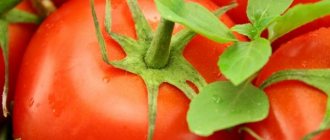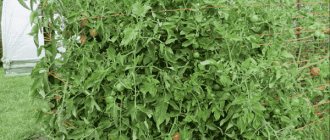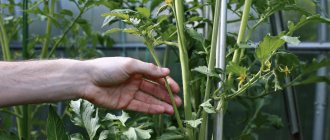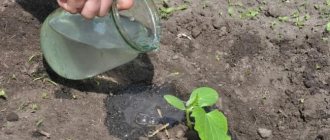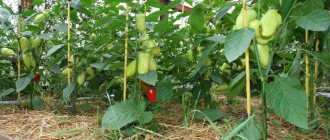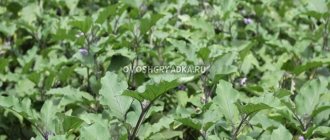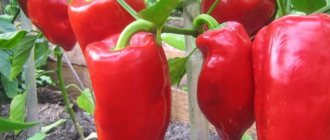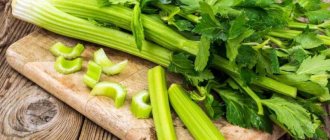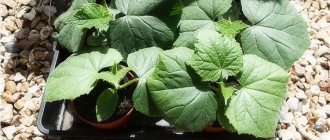Iodine
Feeding is needed for the entire growing season. When the fruits have formed, tincture of iodine will help speed up the redness. It is sprayed onto the upper part of the plant, paying attention to the root part and stems. The solution requires a bucket of heated water and iodine (35-40 drops). If the effect is incomplete, fertilizing is repeated after a week.
Spraying is best done in calm weather in the evening. This way the drug will remain on the sheets and will not damage them.
How to pick tomatoes
- During the season, you need to harvest systematically, about once every 5 days, and more often in hot weather.
- Trim tomatoes with scissors.
This must be done very carefully. The slightest damage will lead to rapid spoilage of the tomato. - Harvesting time is morning, before the tomatoes get hot in the sun. They must be dry, without droplets of dew. There is no need to remove the stalks of tomatoes so as not to accidentally injure the fruits. Tomatoes ripen better with stalks.
- Low temperatures harm fruits, causing them to rot. If the night temperature in the open ground approaches plus 5 degrees, it’s time to remove all green tomatoes.
- In the greenhouse the temperature limit is higher - plus 9 degrees.
Potassium humate
The main microelement involved in the formation of fruits is potassium. To make tomatoes ripen faster, they are fertilized with potassium humate. It is classified as an organic product that is harmless to humans. The popularity of the drug is due to the availability, increased size and improved taste of the fruit. The solution is prepared in the following steps:
- mix 10 g of humate and 2 liters of warm water;
- leave for 2 hours;
- diluted with water in a ratio of 1:10.
The resulting product is used to water the bushes closer to the roots. Potassium humate is universal, so it is suitable for any variety of tomato.
When watering, try to prevent moisture from getting on the leaf blades. Because of it, late blight develops.
Conditions necessary for long-term storage and ripening of green tomatoes
The ripening time of unripe tomatoes harvested depends not only on the degree of ripeness of the fruit, but also on storage conditions, especially temperature.
- For long-term storage (until the New Year), picked tomatoes require a temperature of 10-12 °C and a humidity of 80-85%. Dry air will quickly make the fruits flabby and wrinkled. Sunlight accelerates ripening; for long-term storage, a darkened room is preferable.
- For rapid ripening of tomatoes (7-10 days), a temperature of 20-24 °C is required (house or apartment).
- For very fast ripening (just a few days), the tomatoes are kept in the sun at an air temperature of 28-30 °C.
It should be remembered that with accelerated ripening of tomatoes, an unripe dense area of yellow-green color remains around the stalk. The fruits are soft and have a short shelf life.
Ash
To help green tomatoes ripen faster, use wood ash. In mid-late summer, a solution is prepared from it. In dry form, it is used only when planting seedlings. The ash solution is prepared in this way:
- take 2 kg of ash;
- pour 3 liters of boiling water;
- stir thoroughly, cool;
- dilute 10 liters of cold water;
- add 30 ml of iodine and 10 g of boric acid;
- leave for 1 day;
- dilute again in a ratio of 1:10.
The liquid is used to water plants at the roots. 1 bush requires 1 liter of solution. Necessary microelements are released from the ash into the soil; boron and iodine stimulate ripening, improve taste and yield. This method allows tomatoes to be stored longer and protects against late blight. After application, observe the color of the tomato. If the stems become fleshy and a blush appears on the fruits, one feeding is enough. In cases where there are no visible changes, the procedure is repeated after a week.
The ash solution is added to the pre-watered soil. This protects the plant roots from burning.
Ash is a complete organic fertilizer. It contains a lot of potassium, phosphorus, magnesium, calcium. In the process of burning plant residues, nitrogen is completely evaporated, so it is ideal for feeding nightshades during ripening. The product increases the resistance of tomatoes to temperature changes, makes the peel soft and the flesh aromatic. The ash also contains enough magnesium, which is involved in photosynthesis and the formation of starch and cellulose.
Tomatoes growing in a greenhouse are fertilized with ash solution, potassium humate and iodine solution. After irrigation, the door to the greenhouse is closed. It is ventilated in the morning and evening to remove condensation.
Methods associated with minor damage to the bush
Often a situation arises when there is an urgent need to accelerate the ripening of tomatoes due to the imminent onset of frost. There are 2 ways to achieve rapid redness. The bush is pulled out of the ground a little so that the upper roots are torn. The soil must be dry at this time so that the plant is held firmly. If the soil is wet, the bush can be accidentally pulled out completely if you pull too hard.
Tomatoes. The illustration for the article is used under the standard license ©v-ogorode.ru
A careful cut is made along the main stem with a sharpened tool. The damaged area is sprinkled with activated carbon or ash. This method is not suitable for accelerating the growth of tomatoes in the summer.
There is a way to speed up ripening if the fruits are in clusters. To do this, completely stop watering the plant for a while. Also, no fertilizers are applied during this period. All the tomatoes will start to turn red because of this. If the bushes are in a greenhouse, then it should be closed for the day. The air temperature in it will rise, and due to this, ripening will accelerate. In the evening, on the contrary, the greenhouse is opened to reduce the humidity that has increased due to evaporation. Otherwise, the risk of late blight increases.
Greenhouse with tomatoes. The illustration for the article is used under the standard license ©v-ogorode.ru
It is possible to speed up the ripening of tomatoes in bunches by cutting off the leaves, exposing the stem in this way. Only the top few leaves are left untouched. Do the same if you want to protect the bush from late blight. The disease begins to affect the plant from the lower leaves located near the ground.
It is possible to achieve rapid ripening of tomatoes if you pinch the top of the head after the bunches of tomatoes appear. After this, all the nutrients will go to the fruits.
Any mechanical damage to tomatoes can increase the rate of ripening. If the fruit is cracked, it will ripen a week faster than whole fruits. To do this, summer residents pierce the tomatoes with a toothpick. Damage is caused around the stalk in the amount of 2-3 pieces.
Ready-made drugs
Fertilizers with a minimum nitrogen content have been developed for feeding fruit-bearing tomatoes. They are safe because they do not contain components harmful to the body.
Mortar
The drug is suitable for greenhouse tomatoes and outdoor plants. It is produced in 2 varieties - Mortar A and B. The first is applied under bushes that are lagging behind in development, and the second is used after the first fruits are removed. A solution is prepared from the drug: 100 g of the drug is dissolved in 10 liters of water. It is applied every 7 days by the root or foliar method. In the greenhouse, the product is applied with an irrigation or sprinkling system.
The drug contains boron, manganese, copper, molybdenum, zinc in salt form.
Planter
Planter is a water-soluble preparation for fruit ripening. It contains basic microelements (phosphorus, potassium) in chelated form. The solution is used for foliar feeding of tomatoes. It is prepared from a bucket of water and 25 g of product. Also suitable for restoring plants after overwatering.
Growth regulator Senor Tomato
Senor Tomato is a concentrated preparation containing ethephon. The substance is metabolized and forms ethylene. The product has a contact and systemic effect. It regulates the growth of the vegetative part and affects the ripening of fruits. Additional effects include increased protective properties against heat and drought, protection against viruses and fungi, and increased productivity.
Ethylene inhibits auxin transport and gibberellin synthesis, regulating the growth of tomatoes artificially. In addition, it stimulates the formation of pigment, sugars, cellulose and lignin. Due to such mechanisms, maturation is accelerated.
How to store green tomatoes so they turn red at home
Most of our country is in the zone of risky agriculture. Warm-loving crops such as peppers, eggplants and tomatoes rarely produce a full harvest of ripe fruits. Usually you have to remove unripe and sometimes completely green tomatoes. Experienced gardeners recommend picking fruits at ripeness, without waiting for complete redness, so that the plants have more strength for further fruiting. A special case is the mass disease of tomatoes with late blight. A harmful mushroom can destroy a crop in a matter of days. Tomatoes collected from such bushes will most likely get sick.
Interesting: How Long Can Raw Meat Stay in the Refrigerator?
other methods
The reddening of fruits goes through several stages. At first the tomato is light green, then turns brown, and by the end of 3-4 weeks it turns red. If it lacks nutrition or the microclimate is not suitable, the process is delayed. The following activities can stimulate the ripening of tomatoes:
- remove the lower fruits so that the energy goes to the remaining berries;
- thin out tomatoes if planting is too dense;
- do not apply nitrogen fertilizers at the end of the season;
- give enough potassium with fertilizing;
- create diffused light for the bushes.
Direct rays of the sun delay ripening or burn tomatoes. If there is too much light, the berry turns yellow in the stalk area. The exception is some varieties of tomatoes, which turn red unevenly. Simultaneous ripening of all fruits is observed only in hybrid species.
To adjust the lighting, the bushes are tied up, turning the lush part to the south side. If the tomatoes have grown thick, the excess leaves are removed. It is not advisable to leave the fruits unprotected; the plates should shade them a little. The lower leaves and fruits are also removed. When the bush is actively developing, they take nutrients and delay redness. Experienced gardeners remove new flower stalks and also pinch the tops.
To make the bush shed excess leaves faster, it is sprayed with a 1% solution of table salt.
From green to red: how to speed up the ripening process of tomatoes in effective ways
There is a strong opinion: the most delicious and sweet ground tomatoes are those that are fully ripened in natural conditions in the garden. It is useless to argue, the increase in yield from harvesting tomatoes at the stage of technical maturity is small, the taste of such tomatoes is a purely subjective assessment.
Most often, people resort to picking unripe tomatoes out of necessity - cold weather is approaching, and the fruits simply do not have time to ripen. Originally from the tropical zone of Latin America, tomato bushes cannot tolerate cold weather at all: they begin to suffer from all possible fungal diseases. As a result, the tomatoes remaining in the garden rot on the vine.
Added to this scenario is the possibility of early night frosts, which will definitely destroy the planned late harvest of tomatoes.
Nutrition
Limiting food from the soil helps speed up ripening. With an excess of substances, the tomato will develop a vegetative mass. If you reduce the amount of macro- and microelements, the fruits ripen faster. To make the berries fill faster, the trunk is tied with copper wire. It reduces the supply of minerals and protects against late blight. The second way is to insert a wooden plate into the main branch. Usually it is placed 10 cm above the base of the bush.
When one bush ripens, the redness of the berries on others is stimulated. Ripe tomatoes produce ethylene, which serves as a catalyst.
When ethylene alcohol vapor appears in the air, neighboring bushes turn red after 3 days. This effect is created artificially. A few milliliters of alcohol or vodka are injected into the nest of berries. The second option is to place an apple or banana peel that is starting to rot under the bush.
This is important to know: which picked tomatoes are suitable for ripening?
To obtain maximum yield, the most delicious varieties of tomatoes, mid-late and late, require thoughtful formation of the bush. In the conditions of the Central region, in an open ground bed, 3 lower clusters of tomatoes ripen, and then only under favorable circumstances.
Even if you carefully follow all the recommendations of agronomists, no one is immune from the fact that the tomatoes do not have time to ripen:
- All plans for the harvest can be disrupted by weather. Cold nights or wet, rainy weather are not conducive to the ripening of tomatoes. To protect the crop from rot, tomatoes must be removed.
- Not all summer residents mercilessly pinch the top of the bush immediately above the 3rd flower cluster. Due to forgetfulness, busyness, excessive pity for the plant or the desire to grow more crops, at the end of summer the bush is hung with green tomatoes of various sizes.
Summer residents know that tomatoes picked from the bush can ripen on their own.
This pattern does not always work. Instead of juicy red tomatoes, after a couple of weeks of ripening, you can end up with unappetizing, wrinkled tomatoes.
Interesting: How to quickly dry a mastic figure
Extending the shelf life of fresh tomatoes
Tomatoes of mid-late and late varieties, picked in a state of milky-waxy ripeness, can ensure the daily presence of fresh tomatoes and dishes made from them on the menu.
Long-term storage of varieties such as “De Barao”, “Rio Grande”, “Bull’s Heart” and similar varieties with dense pulp and strong skin is best. For storage during ripening, it is advisable to collect tomatoes together with the stem.
The numerous varieties of “Cherry” that are now popular are well stored directly on the branches, tied in bunches and hung in a cool place.
Which unripe tomatoes should you take?
In the event of an unexpected cold spell or the risk of crop loss from late blight, it is better to remove all the fruits in advance, without waiting for the outbreak of an epidemic of fungal diseases and rot. Tomatoes picked unripe can be stored much longer than usual, until the New Year.
For ripening, it is necessary to take only strong and elastic fruits. The matte surface of a tomato indicates a possible late blight infection - it is better to keep such fruits separately and quickly use them for food.
Tomatoes of varying degrees of ripeness - green, milky-waxy, brown, almost ripe - it is advisable to ripen separately.
Since large tomatoes ripen first, small ones much later, it makes sense when storing for ripening to sort the fruits not only by degree of ripeness, but also by size.
What not to do
Certain actions can delay the ripening of tomatoes. August marks the period with the highest temperatures, so vegetables begin to be watered abundantly. Tomatoes react negatively to sudden changes in humidity. Then the fruits crack or wither.
To prevent the soil under the bushes from cracking in the heat, it is mulched with hay. It slows down the evaporation of water, and the bacteria contained in it fight late blight.
It is also not recommended to give nitrogen with fertilizing. The microelement can be added until the second half of summer. It stimulates root growth and leaf growth. Coming from the soil, it accumulates in tomatoes. Prohibited fertilizers during ripening include mullein and bird droppings. Even in regions with warm autumns, where tomatoes grow until October-November, it is advisable to use potassium-phosphorus fertilizers.
Summer residents often have to pick tomatoes unripe and leave them to ripen in the basement. Such vegetables are inferior in taste to ripe tomatoes. Therefore, proper fertilizing will speed up the harvest.
What to do to make tomatoes turn red faster
You can achieve rapid ripening of tomatoes in different ways. But all of them will resemble resuscitation measures rather than traditional agricultural techniques, so the gardener should not forget about the rules of basic care and the recommended conditions for this crop.
Did you know? For the first time, the appetizing fruits of tomatoes began to arouse the interest of chefs after in 1822, retired Colonel Robert Gibbon Johnson, having lost faith in the fairness of American courts, decided to poison himself with a bucket of tomatoes right in front of a crowd of thousands gathered at the steps of the Salem House of Justice in New Jersey. . Expecting that after such a meal the man would writhe in terrible death throes, some lost consciousness, while others called doctors to stop the daredevil. Naturally, the colonel survived.
In emergency cases, when due to prolonged rain or cold weather it is necessary to immediately save the crop, various tricks are used. Let's talk about them in more detail.
On a bush in open ground
To make tomatoes red and juicy faster, experienced housewives advise:
- Do not delay removing the first ripe fruit. Thus, intense stimulation occurs for the remaining ovary.
- Bare the stems of the plant up to the first cluster of inflorescences. This is done by removing foliage to ensure good ventilation, as well as to prevent late blight. Particular attention should be paid to branches that touch the ground.
- After the ovary appears, pinch off the tops of the central stems, grabbing a few leaves. The procedure is aimed at stopping the growth of biomass and stimulating fruit filling.
- A month before harvesting, stop watering completely. During drought, it is recommended to limit their number to a minimum. But this absolutely cannot be done in areas with deep groundwater. The method will not only speed up the ripening time of tomatoes, but also improve their taste. The product will be juicy, but not watery, and will also lose its sourness.
- Carry out pinching of bushes in a timely manner. Thanks to this, the plant will not waste its internal resources on stretching stems and growing foliage, directing them to fruiting.
Torn off
In cases where the weather does not allow tomatoes to ripen on the vine, and the entire crop has to be harvested green ahead of schedule, the following methods will come to the rescue:
- Store fruits on stems in a warm, dry place. To do this, the plants are completely torn out of the ground and hung from the ceiling by their roots. Thus, nutrients will briefly provide the ovary with growth energy.
- Wait for ripeness by laying the tomatoes in rows on the windowsill on the south side. If it is cloudy outside, you will have to additionally illuminate the vegetables with fluorescent lamps.
- If it is necessary to accelerate the ripening of a large number of fruits, they are torn from the branches, placed in a plastic lattice or cardboard box and covered with a warm blanket on top. And in order for the necessary biological processes to occur faster, it is advisable to place at least one ripe tomato (an apple or a banana) into the container. The fact is that a ripe fruit produces an aging gas - ethylene, which contributes to the ripening of the entire crop.
Did you know? A Wisconsin farmer (United States of America) managed to grow a record-breaking tomato. The fruit was the size of an average watermelon and weighed almost 3 kg.
To make picked tomatoes turn red faster, it is recommended to place them in a dark and warm place. For full ripening, 2–5 days are enough. Some vegetable growers advise wrapping each tomato in paper and laying it in layers in a box. But this option is acceptable for a small harvest.
In any case, damaged or spoiled fruits should not fall into the container. In addition, the lower tomatoes can quickly become unusable under the weight of the upper ones, so you should not make more than 5 layers in a box.
When choosing a place to store unripe vegetables, you should avoid dampness. With high humidity, they will instantly become infected with putrefactive infections. Knowing how to pack an unripe harvest and where to put it, you can delight your family with fresh homemade tomatoes until December.
How to feed tomatoes in a greenhouse
For greenhouse tomatoes, the same fertilizing and spraying is used. In order for the tomatoes in the greenhouse to fill and turn red faster, the doors of the room are kept closed most of the day. In the morning and evening hours, ventilation is carried out to remove condensation from the greenhouse.
These simple rules for the care and nutrition of tomatoes will help you harvest stable, rich harvests of ripe fruits.
Did you like the article? Share with your friends:
Hello, dear readers! I am the creator of the Fertilizers.NET project. I am glad to see each of you on its pages. I hope the information from the article was useful. Always open to communication - comments, suggestions, what else you want to see on the site, and even criticism, you can write to me on VKontakte, Instagram or Facebook (round icons below). Peace and happiness to everyone!


